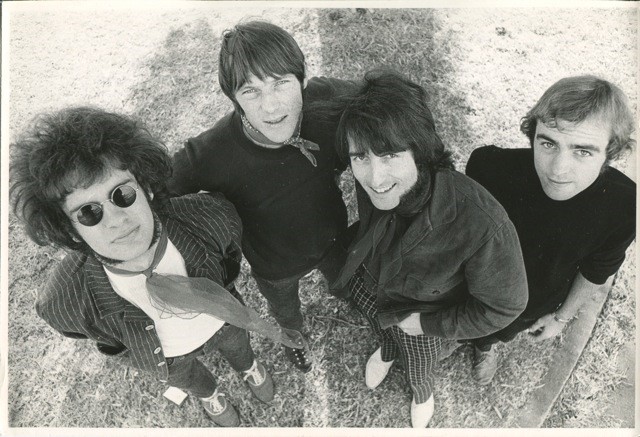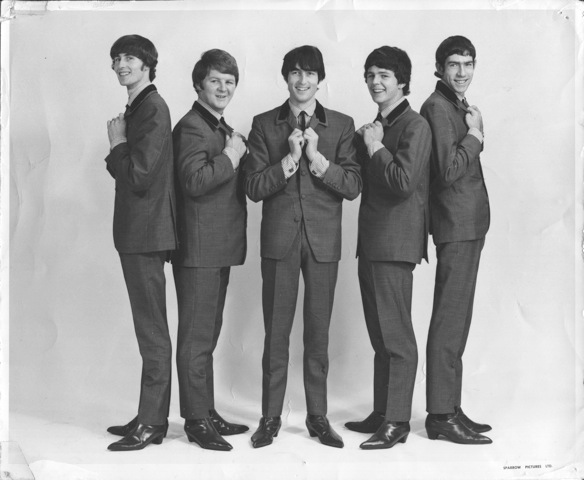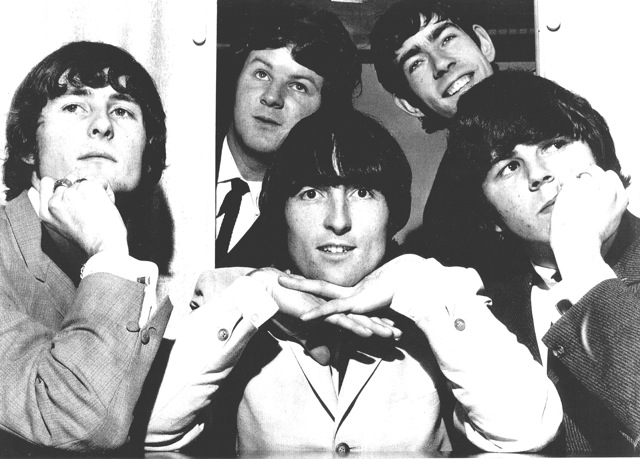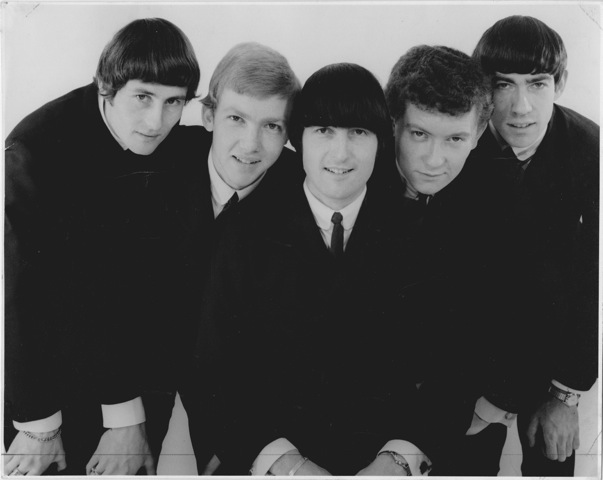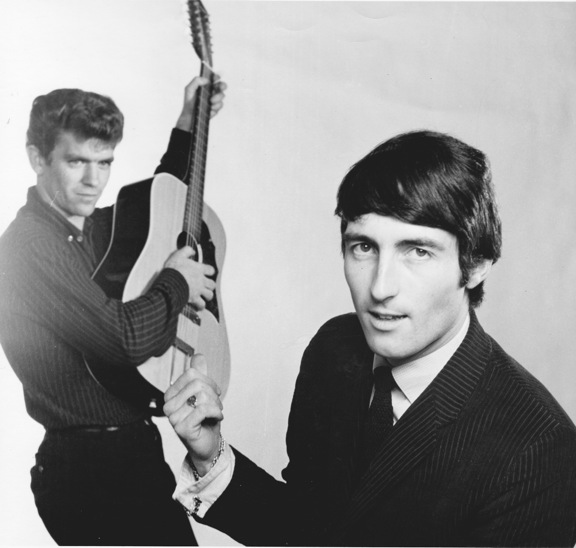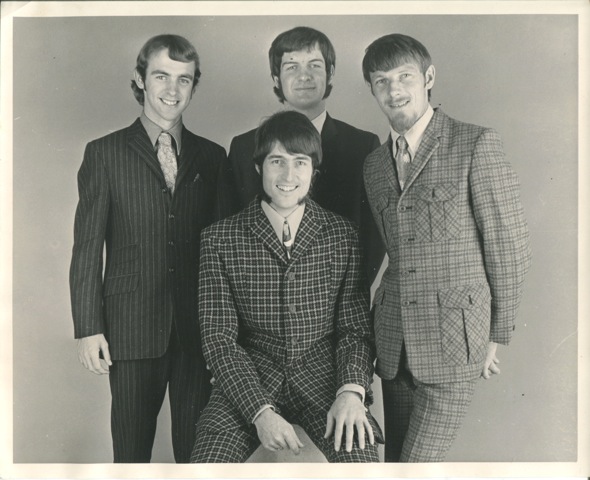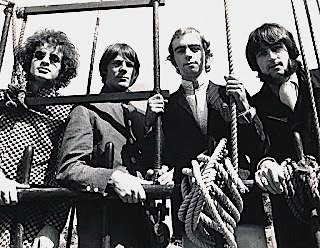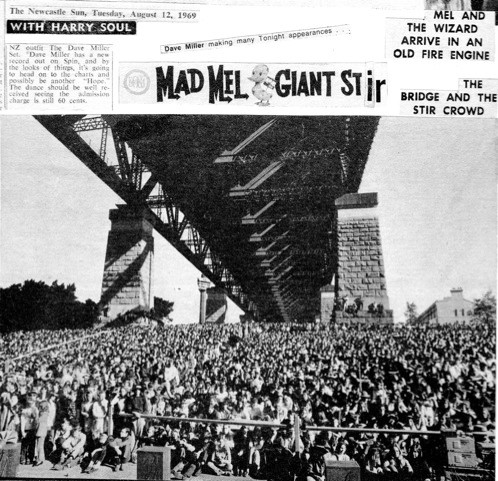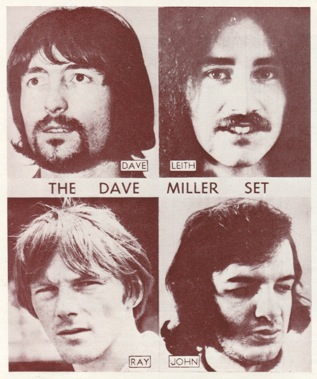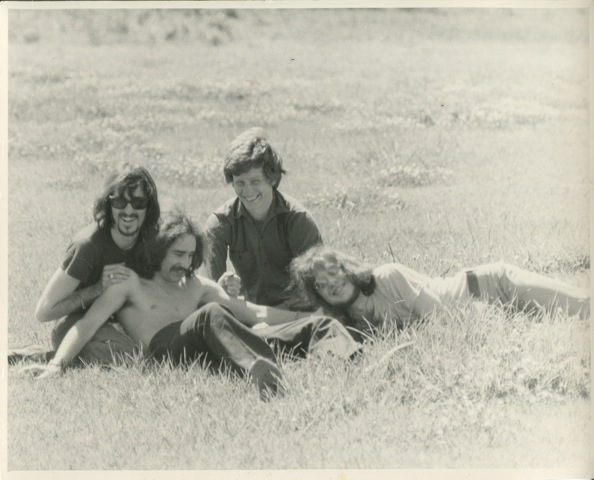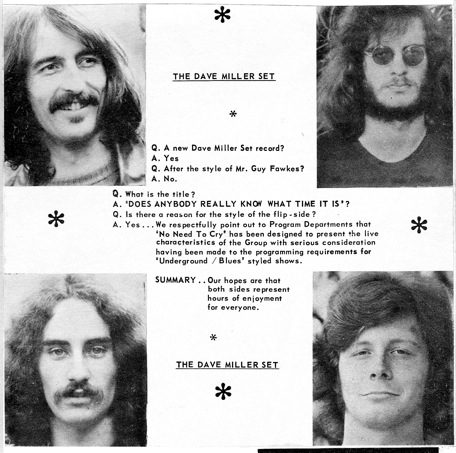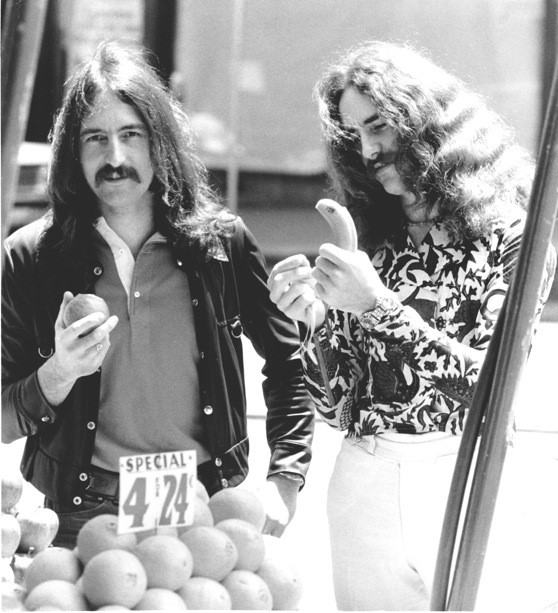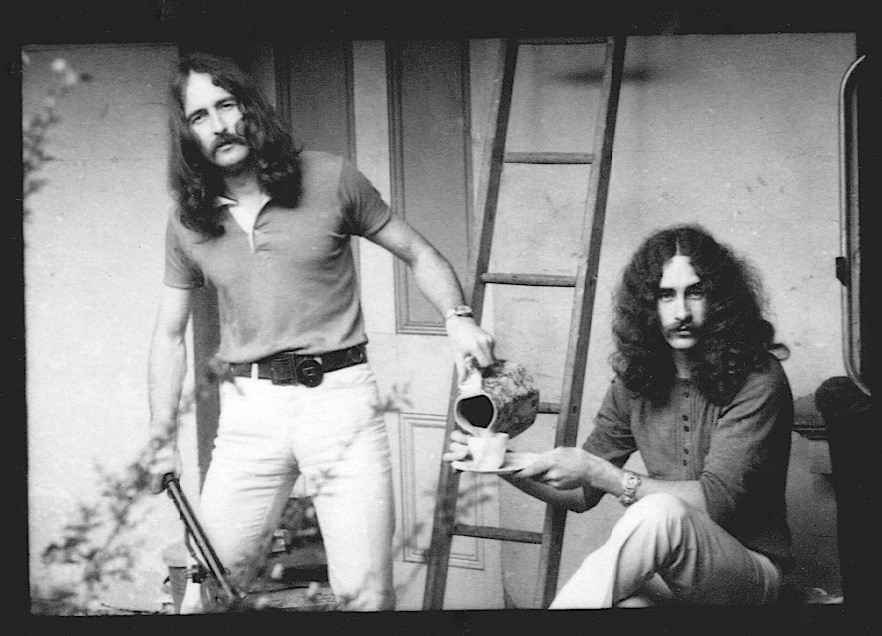The Dave Miller Set were a pivotal group in the 60s music scene down under. One of the most popular bands on the Aussie east coast in the late ’60s they released a string of now revered singles including the classic 7 incher ‘Mr Guy Fawkes’, Go-Set magazine’s Single of the Year for 1969. In hugely rich detail including rare and never seen photographs, Dave Miller tells Jason Barnard about his time in the New Zealand and Australian music scene.
The Dave Miller Set, taken to promote ‘Hope’ 1968. From left to right: John Robinson, guitar: Ray Mulholland, drums: Dave Miller, vocals: Bob Thompson, bass
What led you to joining your first band The Playboys/Byrds?
The Playboys were put together by singer, Phil Garland, for both his benefit, and the benefit of a female vocalist, named Diane Jacobs. My brother, Graeme, was the first member of the group recruited, and he was the drummer. This all happened early 1962. They gigged very successfully around Christchurch for a period of 18 months. The band used to rehearse at the Miller family home, and on occasions, if Phil was running a bit late for rehearsal, I would frequently jump in and sing some of their new repertoire songs, for expediency. Our family home was in the suburb of St. Albans, and the street was named Mersey Street. In my time, I used to love telling interviewers and others, that it was the Christchurch home of ‘Mersey Beat’.
In mid-1963, the band scored a 4 week deputising gig, in Auckland, to step in for Max Merritt and ‘The Meteors’ while they were touring to promote a new record. Phil and Diane liked the notoriety that was heaped on them in New Zealand’s ‘biggest smoke’ and decided to turn professional and re-locate there to pursue their respective careers. I received a telegram, from Graeme, which read: ‘Give Up Smoking. (stop). Learn Some Songs. (stop). You Are Our New Vocalist. (stop). Phil eventually became a folk singer, and noted NZ folk music historian. Sadly he passed away in 2017. Diane adopted the stage name of ‘Dinah Lee’, and became the mod queen of Australasia with a string of hits to her credit.
The Playboys – before the name change to The Byrds. It is from our Christchurch era, 1964. From left to right: Graeme Miller, drums: John O’Neill, bass, backing vocals: DM, lead vocals: Kevin O’ Neill, rhythm guitar/ backing vocals (brother to John): and Brian Ringrose, lead guitar / backing vocals. [Brian passed away, August 2017]
What bands/music did you follow at the time – was it Aus/NZ, UK or US music?
I loved music from the day I could turn the knob on the radio. As a kid I heard every style of music, probably like Lennon and McCartney and others. New Zealand radio was very British, in my youth, and the population drove Austins, Morris’, Vauxhalls etc. The antipodean ‘down under’ aped the ‘Mother’ country. Because of it, radio was tipped in favour of the British. It’s fair to say Elvis changed things. By my teen years it was 50/50 UK, US. When I became a Playboy, in mid-1963, Mersey Beat, the British Beat Groups, and Beatlemania were in the midst of a powerful ‘grip’. It was an exciting time. Teen dances, which had languished since the first wave of rock’n’roll, were enthusiastically revived. For bands the performance fees were not very great because all liquor licensing ceased at 6:00 p.m. every day. Without alcohol sales to boost band fees, it was all very ‘wishful thinking’! Teenagers didn’t get much of a look in and radio only really featured pop music in a Top 20 format on one night of the week, for around an hour. As a consequence audiences demanded renditions of the latest chart pops because of ‘the drought’, and the limitations! It did stifle creativity. I sang a lot of the English hits, in my new role as a Playboy. Songs from the likes of The Beatles, The Searchers, The Hollies, Gerry & The Pacemakers, Billy J Kramer & The Dakotas, Brian Poole & The Tremeloes, and lots of others. In fact, on my first public appearance, fraught with nerves, I sang the current number one song of the week, ‘How Do You Do It?’ Got a ‘fairy-tale’ reaction, and that was all I needed.
The Byrds, 1965, publicity photo for ‘Bright Lights, Big City’. From left to right: Graeme Miller, drums: John O’Neill, bass: Dave Miller (front): Brian Ringrose, lead guitar: Kevin O’Neill, guitar / vocals (front)
Was having the same name, as the US group, a help or hindrance?
Most positively, a big hindrance! We chose the name, The Byrds, as soon as we turned professional, December 1964. The reason being that Tom Jones had been associated with a ‘Playboys’ outfit. There was comedian Jerry Lewis’ son, Gary Lewis & The Playboys who had a monster hit with ‘This Diamond Ring. But, closer to home, in that time, the young Aussie king of pop was Normie Rowe, and his backing band was The Playboys, and they were getting a lot of airplay in NZ. Our Byrds had been selected, because of their on stage performances, to do the farewell summer tour with New Zealand’s greatest vocal Quartet, The Howard Morrison Quartet. They were legendary, and, to this day, one of the greatest success stories ever! They were calling an end to that phase of their careers and we were chosen to represent the pop group part of an expansive package. The whole show was staged in soundshells, theatres and the like, around major North Island beach resorts due to our extended summer holiday schedule. It positively launched The Byrds and we played to hundreds of thousands of people over a two and a half week period. It concluded New Year’s Eve,1964, in Howard’s home town of Rotorua. From that point on, we gigged as The Byrds. Mr. Tambourine Man was released, June 1965, and by that stage we had ‘Bright Lights’ as a major success everywhere and it had been in the market place for more than three months. Our audiences were totally confused because of the name clash. Zodiac Records were quick to react and responded in the second round of pressings by putting my name out the front…..Dave Miller & The Byrds. At first the Americans were ‘the other Byrds’, but with the impact clout they could produce it didn’t take long for us to be referred to as ‘the other Byrds’. These days I see it in a totally different light…. It has always been a talking point, and you and I are doing that now. I have reasoned that if we are going to talk about it, then we haven’t been forgotten.
Final line-up of The Byrds – the ‘No Time’ / ‘Love Is All I Need’, era and the ‘hard to get’ 5 track EP, with the title ‘Dave Miller & The Byrds’. From left to right: Graeme Miller, drums (brother): Chris Collier, bass / vocals (originally from Liverpool, UK): Dave Miller : Al Dunster, guitar backing vocals: Brian Ringrose, backing vocals / lead guitar
How did you choose The Byrds songs for live shows and the band’s singles?
I hope this doesn’t read wrongly but I can best explain that by saying that I have always had ‘good ears’ and an instinctiveness about songs. Being the lead vocalist it was down to me to choose the material that I thought that best suited us. Naturally the other guys had a say in matters, but it all seemed to work very comfortably. I didn’t ride ‘rough-shod’ over the others. They were happy with it.
I understand you supported some UK/US acts in New Zealand.
Yes, that’s true. That first started happening in Phil Garland’s time. It carried over into my time, as well. I must point out that in those early 60’s times we didn’t travel on tour packages. What promotor’s did, was pick a prominent band in each main centre, the tour was due to appear in, and have them open the show. Obviously it saved substantially on transport, accommodation, and so on. As The Playboys, who stood out in Christchurch, we were picked where time would allow. As a consequence we didn’t get get to know the major artists. In fact, sometimes we didn’t even see them. The Playboys did work with American folk/pop singer Jimmie Rodgers and the group backed him. The rapport was really great, and he genuinely liked the band. We did get to know most of the international artists on a ‘Surfside ’64’ show. The bill featured Roy Orbison, The Beach Boys and The Surfaris.
We had a great after show night with The Beach Boys and The Surfaris. We all spent two or three hours together and socially it was a really pleasant way to conclude a great concert gig. I must add that Mr. Orbison retired to his quarters directly after the show, so he remained a ‘mystery’. I had a very encouraging time talking with Roy’s drummer who had great stories to relate about session work in Nashville. I, personally, picked Al Jardine’s brain about all sorts of musical related events. The ‘down under kid’ getting a sample of life in the big musical world.
I should add that ‘Bright Lights Big City’ did appear on an EMI vinyl LP, in the 1980’s, called ‘How Is The Air Up There?’ It was re-issued in the late 90’s as a CD. Zodiac Records has, over time, put out a download series called ‘The Zodiac Heritage Series’. Volume 16 features ‘Little Lover’, and, the most recent, Volume 17, has the title, ‘Love Is All I Need’, which was, initially, the B-Side of the ‘No Time’ single. It is a fact that the Mr.Guy Fawkes CD has stirred up real interest in The Byrds era. That pleases me because, in their time, The Byrds held their own with all comers, and by mid 1965 were headliners, in their own right.
Dave Henderson (left) and Dave Miller (right), before both they left Christchurch for Australia, 1966
Why did you go over to Australia?
I certainly had a few false starts getting to England. I even asked Eldred Stebbings, of Zodiac Records, to sound out the Star Club, in Hamburg. I figured that if it was the way for a number of English groups to gain prominence, then why shouldn’t we? He did write to them and received the reply, ‘We will be happy to look at them if they get themselves over here’. I think I was secretly hoping that they might finance us. The dreams of youth! After the demise, of The Byrds, I worked frequently, as a solo, in Christchurch and Wellington. In early 1966 I became engaged to my girlfriend, of over two years, and still harboured plans of going to England. Out of the blue, her family decided to migrate to Australia because they loved Sydney, and that effectively put England, once again, on the back burner. They sold up and left, and two months later, I decided to check it out for myself.
How did the Australian music scene compare with New Zealand?
I learned very quickly the Sydney club scene was vibrant and well run. Artist fees were very good because of extended liquor licensing and poker machines. I also learned quickly, that to cement a life career, with security, any group, or artist, needed a ‘hit’ track record. It was all rather Las Vegas and a real achievement name was a pre-requisite. The pop mainstream was a very different kettle of fish! By comparison to New Zealand, it was not run near as efficiently. It was somewhat off-set by the youthful enthusiasm of the young population. Like in all nations, there has to be youth music and music that denotes the time. The big difference was the volume of population. On the balmy night I flew into Sydney, in April 1966, the sky was absolutely clear and, it dawned on me, as a looked down on an expansive, sprawling metropolis, that Sydney housed the equivalent of the entire population of New Zealand, just beneath me. There was a belief that the greater the numbers, the bigger the fees. Somehow it doesn’t always work like that.
The Dave Miller Set, 1967. From left to right: Bob Thompson, bass: Dave Miller (seated): John Robinson, guitar: Ray Mulholland, drums
In my time with The Playboys, Byrds & The DMS we did not have management, and I handled all the business affairs. At no time did I find anyone with the business acumen that I considered necessary. That does not mean that they didn’t exist, it does mean that no one entered my sphere that I could be satisfied with. It did have its drawbacks. For instance you can’t paint glowing pictures about yourself, even if they are true, because that would denote an out of control ego, and in ‘down-under lingo’, the signs of someone totally ‘jumped up’! I did use booking agencies because we were out on the road constantly, and as a consequence I did need a telephone answering service. I have said, in more modern times, that mobile phones would have been a blessing, in my position, back then. Remembering things from a couple of stand points does activate the memory.
Dave Miller, backstage, 1968
What led you to form The Dave Miller Set?
I came to Australia, in tow, with another Christchurch guitarist/singer, named Dave Henderson. We did not know each other, but naturally enough, knew about each other. We shared digs in Sydney’s Kings Cross, and, unbeknown to us, we were right in the heart of the ‘red light district’. We became known to the ‘girls’, as the ‘would be pop stars’. Far too worldly for a couple of ‘sheltered’ Kiwis! A lot of New Zealand artists and bands were working the Sydney Pubs and Clubs and, as the pair of us did the rounds we got some great audience introductions. The Byrds track record helped considerably. We put together a club styled act singing Simon & Garfunkel and Everly Brothers etc to get a foot in and a feel for the Aussie way. It all seemed promising, then, out of the blue, Dave had a family emergency back home in Christchurch, and was gone within 24 hours.
I ended up at a disco named ‘The Bowl’, which was an established teen venue set up, initially, for the presentation of ‘Sunshine Records’ recording artists. The ‘king’ of pop, in Australia, at that time was Normie Rowe and he was the Sunshine Label poster boy. The Bowl was managed by another Kiwi, Graham Dent. He had a managerial and promotional background, and, in his time had managed some top NZ names. I thought I would sound him out and see if he could point me in the right direction. The day I walked in to meet him, he was walking out. I said to him: “Graham, my name is Dave Miller”. As quick as a flash he said to me: “I know who you are, and what you have done. You can sing, and talk, and I guess you you know how to spin records. We need someone like you here. You can start tonight. See you later.” That it was it. I became disc jockey, compere,house vocalist and general factotum. The Bowl functioned lunch-times, as well evenings and for the next six months I virtually lived there. I ended up with a very good name and reputation amongst all the Record companies, spinning their product. It came back to work in my favour at the time of discovering Mr. Guy Fawkes. The most important aspect of working The Bowl was that, because of my experienced background, I was called on to deputise for major artists when untoward circumstances cropped up. If, for example, a star was flying to Sydney for a TV appearance and a flight was delayed, I was despatched to fill in at very short notice. The same applied for live performance engagements. If an artist could not appear, for any reason, I was called in. The consequences of those ‘fill in’ engagements meant, that within a relatively short space of time, I was actually getting quite a number of return engagements off my own bat. My name and reputation started carrying weight.
It also spilled over to interest from the A&R chief of Spin Records, Nat Kipner (the writer of; ‘Too Much, Too Little, Too Late’ for Johnny Mathis & Denice Williams), he saw and heard me quite often and decided Spin was going to record me. I think I am the only artist that never auditioned. In the latter part of the year, the Bowl hierarchy decided to move in the direction of a licensed night club with floor-shows and late closing. More adult. I was asked to put together a ‘house band’. I immediately called Auckland, NZ, and spoke with drummer Ray Mulholland, of New Zealand Rayders fame. He jumped at the idea. I then pulled in three musicians, from Sydney, for guitar, bass, and keyboards.
The Dave Miller Set, early 1968. Framed around the rigging of a sailing ship! From left to right, John Robinson, guitar: Ray Mulholland, drums: Bob Thompson, bass (Originally from Didcot, near Reading, UK), Dave Miller
Within a very short time they were in rehearsal mode and then the Bowl management dropped the bombshell that they had reversed their decision! I was left to have to break the news that it was all over. Those same guys got themselves together and decided, with my burgeoning profile, that we should join forces and that they should become my backing unit. They called me and told me of their decision and I was left having to stew on it! I did feel obligated, but because The Bowl had its own booking agency, I knew how absolutely poorly bands were paid on the OZ scene. A solo act fared very much better and I knew, that initially, it would be a very big step backwards. For me it was truly difficult, but I was swayed in their favour. Thus, the birth of ‘The Dave Miller Set’.
Did the first three singles released, ‘Why Why Why’, ‘Hope’, & ‘Get Together’ chart in Australia or New Zealand?
I need to point that back in the 60’s having a recording out, in the market place, was rather a prestige event. It meant that promoters could advertise the act as recording artists. It had the effect of ‘queue jumping’! To get radio play was an absolute bonus. To get a chart hit was ‘the jackpot’. There was a philosophy that we couldn’t quite compete with overseas product, and the best came from elsewhere. The other restraint was that radio had to play ten percent local content. The problem, with that edict, was that it did not stipulate ‘new’ product. Radio stations, therefore, played it very safe, most of the time, by playing ‘flash backs’ which helped fill the quotas. It was not an easy road to travel, but for all that, there was a thrill attached to it. Being young and carefree, pulls on the blinkers! ‘Why Why Why’ was the first Spin release for The DMS. It was a song from Paul Revere & The Raiders and it was in a 3/4 time signature. I found it and heard something I liked but I knew it needed ‘a bit more fire in the belly’. When we presented it to our intrepid producer, Pat Aulton, he said: “Yes, that’s going places, but we are going to have to ditch the 3/4 ‘feel’. I said: “Why”! “Because, he replied, the other side of the record is also in 3/4 time”. “But we haven’t settled on the other side, yet”, I said indignantly. “Spin have decided to use the band’s tryout recording of, ‘A Hard Hard Year’, he said, with a shrug. That decision induced just enough fire for the band, collectively, to ‘tear the song apart’ and give it a thumping 4/4 ‘feel’. There was just enough ‘anger’ to stoke it into a whole new realm! ” You got it”, Pat said with a victory shrug. It got some airplay in Sydney, on its release, but radio was being cautious. The band ‘ocean cruised’ to New Zealand for a major tour December/January 1967/1968, and that coincided with its release. Like in the UK, Auckland, too, had a pirate radio station, in the 60’s — Radio Hauraki. Because of my track record with The Byrds, and Ray Mulholland’s success with The Rayders we were a very acceptable novelty in 1967. In the lead up, to Christmas, we did quite a number of interviews with various Hauraki presenters for a variety of shows, and, as a consequence ‘Why Why Why’ got plenty of airtime. All that was conducted on land, then broadcast at sea. Other North Island regionals picked up, on all the action, and ‘Why Why Why’ made the Top 40 charts in a lot of places.
‘Hope’, on the other hand, was a song Pat Aulton thought we would handle extremely well. It was by The Candymen, who had been Roy Orbison’s backing group. Ward Austin, of radio 2UW, who had done various shows with us, really liked it and got behind it on his radio program. In The DMS territory of The Australian Capital Territory (The ACT), all of New South Wales, and Queensland, ‘Hope’ made it to number 21 on the charts. On the ocean cruise, with the P&O company, December 1967, we met an enthused character, in Fiji, who had a nightclub and a musical instrument shop. He championed our cause. When we returned, the following year, 1968, he organised for the band to perform the first international pop concert in Suva’s brand new civic auditorium. It was an afternoon show due to the ship’s sailing commitment and radio constantly played ‘Get Together’ to promote the event. As a consequence, of all that, ‘Get Together’ went to number one on their charts. It lasted there for a considerable number of weeks. When I learned of its number one ranking, while touring New Zealand again, it occurred to me that because of Fiji’s significant Indian population that it was probably helped along by the sitar played by our guitarist. In ‘our’ territory, in Australia, ‘Get Together’ made it to number 27.
The tracks were covers, did you write in this early period of the group?
Trying to lead from the front, back in the days of The Playboys, and specifically because of the Lennon/McCartney influence, I wrote two songs that were recorded to acetate demos — ‘She’s Alright’ and ‘A Lovin’ Day’. Having no formal musical training I composed them in the manner of Arthur Alexander. I had a girlfriend, in Christchurch, who lived on the complete opposite side of town to me, and after taking her home and travelling some distance, I composed them acappella, in the car. Arthur worked that way, as well, although I didn’t know it at the time. British groups loved his work, in the 60’s. Songs like ‘You Better Move On’, ‘A Shot Of Rhythm And Blues’, and the John Lennon favourite, ‘Anna (Go To Him)’. My first commercially recorded song was, ‘A Bread & Butter Day’, and that was the B-Side of ‘Get Together’, in 1968.
‘Mr. Guy Fawkes’ is now regarded a landmark track did you realise you were onto something special?
The brief and positive answer to that question is, YES. No doubt you have read about the manner in which I cut and edited the song, on an old reel-to-reel tape recorder, to give some indication of what I wanted to do to it, and with it. A few questions back, I alluded to my rapport with the major Record companies, in Sydney, and how Mr.GF evolved from that. My opinion was sought by Phonogram Records as to whether I considered the Eire Apparent LP as being viable for the Aussie market. They loaned me a copy of the album, in a plain jacket. Other than production by Jimi Hendrix I really had no other information. They needed an answer within three days. I was approached for two reasons — (1) They knew I would consider it fairly and, (2) The DMS was one of the leading exponents of heavy, but melodic, rock, in the style of Hendrix and Cream. I dutifully did all that, and, in the process, did a double take on Mr. GF, and ‘Someone Is Sure To’. At the time I already had a song lined up for the next single, after ‘Get Together’, and it was an original called, ‘I Don’t Believe It’. In an age where cassette recorders were used more as dictaphones than music recorders/players, I knew the only way to really tell if I was on the right path, was to learn them, with the band, and see how they fared. I planned to take three songs to the next recording session, and pick the best two. From the word go, I had a vision for Mr.GF, and I could see and hear it in my head. Leith Corbett and I learned it, in the manner I had carved it up on tape. I took it Pat Aulton and explained in my own way how I was hearing it and all the effects that I was adamant about needing. Pat listened to my carved up arrangement, and paid me the courtesy of hearing me out. It was, in effect, a full arrangement in words. All we had to work with was a 4-track studio set-up. He said it was a big ask, but we should be able to do it. The mischievous Irish man, within, loved the idea of the challenge.
Five days out from the recording session I was about to rehearse the band with my song ‘I Don’t Believe It’, when I got a phone call from Pat asking if the guys would like to earn session fees backing a new young singing discovery with the two songs for his first single. Naturally all the hands were held out, and that is the reason both Eire Apparent songs figured on the same disc. I knew, right from the word go, that if I got everything right it could be a standout, but, on the other hand it could very easily be cast off as nothing more than a novelty. Adding the explosion was a huge risk especially for radio programming. My mind was made up, I had to do it! I did oversee it in production, but it was more about being available for any questions Pat might have. He had rehearsed it over, in his head, and to this day, I am grateful for his talent and for realising my vision. Others might say differently, but to my mind, he was as important to Australian music, of the 60’s, as George Martin was, in the UK. There is an amusing footnote to this story. Our bass player, Leith Corbett, was new to the band at the time of Mr.GF and had left another Sydney band, ‘Heart And Soul’. With Leith still in their ranks, they had recorded a song called, ‘Lazy Life’. The A-Side of the session single for the new discovery, was ‘Year Of War’, and the artist’s name was Frank Lewis. All three singles were released around the same time, in 1969, and all three charted significantly in Australian Top 20’s. Leith is probably the first non-session player, in Australia, to figure on three chart hits simultaneously. My song, ‘I Don’t Believe It’, eventually ended up on the LP, ‘Reflections Of A Pioneer’.
Are you aware of Michael Cox revisiting Guy Fawkes as Magnet a few year later? He appeared to incorporate elements of your version back into his song.
Yes, I did learn from my ‘down under’ champion of the song, Nick Black. The thing that sets our version apart is, in my opinion, Leith Corbett’s bass playing. He approached the song in a manner most bass players would not have come to. There is an energy that hints at urgency, without over doing it, and that offsets the reflective middle section. Because of those chosen lines, the phrases, by the strings, are strengthened. At least, that is what I think. Whatever, it did work!
Were you tempted to travel over to London in this period like some of your peers?
I would really have liked that but the Guy Fawkes saga, with the record company, certainly killed off any hopes, of that happening! As you have probably read, on the day of its release the manager of Spin called me into the office, not long after he had played the disc, from his pile of Press samples. It felt like the ‘school boy and the head master’! I was absolutely berated for the worst load of rubbish the company had ever been involved in. He was a really nice man, but on this occasion he was angry. I was told, in no uncertain terms, that he had trusted me, but, not only that, he had trusted Pat Aulton, as well. The pair of us had let him down, and the company, to boot. He went so far as to say that because of his trust he had left us alone to record, but had he followed up on progress, at any stage, he would have ‘pulled the plug’! He made it clear that he hated it!! Even as it climbed the charts, he did not change his thinking. Even when it peaked and was being called ‘a classic’, he did not change his tune. At that time I pleaded for an overseas release. I even pestered Festival Records, who distributed it, but I was looked down on very curiously….. didn’t I know that you don’t take coals back to Newcastle! It’s amusing to reflect, nowadays, how that one song changed some lives. The manager, of Spin who hated it, was, some months later promoted to managing director of TCN 9 Sydney Television for his visionary ways, while Pat Aulton, who had a small production company for recording and arranging scores for TV and radio commercials, was revered for his production work, particularly on Guy Fawkes, and his business expanded nicely. Which pleased me, no end. When reference is made to the Spin Record Company, these days, it is often explained by the words, ‘The company that produced Mr.Guy Fawkes’. When you stop to consider that Spin’s roster, of artists, boasted The Bee Gees, in earlier times, the company’s ‘worst recording’ didn’t do them too much harm.
What were your most memorable live shows with The Dave Miller Set?
The publicity blurb, that surrounds, The Mr. Guy Fawkes CD, states that we were one of the most hard working live acts of the times. That is no lie. It is a fact. As you have probably deduced now, live appearances were how we made our living. In 1969, leading to ‘Woodstock’, outdoor concerts became the vogue, and as a consequence of that, The DMS, and others, played to big crowds and we enjoyed that approach to performing. The theatre concert moguls did not really exist, so, that luxury was a bit further down the track. The Byrds, in NZ, certainly played many more seated concerts than The DMS ever did. For me, there are many notable performance occasions, but the annual springtime Waratah Festival, in Sydney was great for us. It was staged, outdoors, in Hyde Park, right in the heart of the city. The DMS did headline, on a couple of occasions, and our popularity was reflected in the receptions we received. In the lead up to Mr. GF’s chart climb, we were booked for a massive outing under the city side pillars of the Sydney Harbour Bridge. It was the brain-child of a Sydney radio ‘jock’ using the monicker, Mad Mel. He was photographed in some sort of ‘Lone Avenger’ facial hood and, as a venture like that had never been undertaken before, it drew an enormous crowd, on the day. Even the weather behaved! Most of Sydney’s top bands were on the bill, and, the American guest star was Ray Stevens. It was publicly billed as ‘Mad Mel’s Giant Stir’. There is no doubt, our appearance nudged ‘Mr.Guy Fawkes’ upward, in the charts.
Crowd shot from Mad Mel’s Giant Stir under the Sydney Harbour Bridge in July 1969. Dave “This is from one of my scrapbooks. The date you can visibly read applies to a Newcastle gig.”
Can you tell me about the writing of the epic 6 minute rocker ‘Ne Need To Cry’?
I had such good reactions and feedback, to ‘A Bread And Butter Day’, on the B-side of ‘Get Together’, that it gave me the incentive boost to carry on writing. Midway through 1969, the song came to me and, as it was obviously not Top 40 material, the whole band treated it in an extended live performance vein. It developed on stage and became a much requested addition to our stage show. When we rushed ‘Does Anybody Really Know What Time It Is?’ to get it into the market place before the massive ban fallout between record companies and radio stations, ‘No Need To Cry’ was already rehearsed and ready to go. There were no time constraints because radio was never going to play it, the only thing we had to be aware of was that it had to be fitted onto one side of a 7 inch 45.
Was there rivalry or camaraderie between New Zealand and Australian bands?
I found small amounts of envy in both countries, particularly when all of us, as new bands, were on the bottom rung and on a level playing field. There seemed to be a few pangs if, one or more, broke the shackles and got a break upward. Most of the time, in my NZ days, we were all pretty much a bunch of ‘happy campers’. When The Byrds became a national entity,in 1965, we shared the bill, many times, with other successful bands and artists. Because concerts were much more prevalent, in NZ, there were quite a lot of occasions when the entire package would travel by bus. I found those outings to be thoroughly enjoyable. All sharing anecdotes and stories of other amusing happenings. If there were a couple of guitars handy there would often be boisterous sing-a-longs. I found that those who had ‘paid their dues’ were comfortable with others’ successes, so camaraderie was more to the fore than rivalry. It was much the same in Australia. Musos got on with other musos. What I did find, though, was that managers created rivalry by trying to outdo each other. ‘Rutting for supremacy’. There was an occasion when two managers were backstage arguing the toss about which band was to have a more elevated billing. They tried to rope me in because the DMS was on the same plateau. We had to follow that show with another gig, which entailed quite a bit of travelling, so I discreetly said to the promoter: “We’ll go on next”. I gave the lads a nod and said: “Let’s sort this”! In DMS fashion we threw everything at it, and left the same two managers arguing about who was not going to follow the Dave Miller Set!
Publicity spread for the ‘Guy Fawkes’ era, 1969. Note Leith Corbett replacing Bob Thompson.
Why did you break up The Dave Miller Set?
There were three factors involved in the demise of The DMS. The first came via Indonesia.
Because the band had attained an Australasian level of success and had also made its mark in Fiji, approaches were made to our Sydney Agency about an 8-date tour in Indonesia. It was for a package show, headlined by The DMS. It was the first international rock music spectacular ever to be staged in the country. It was a first and we were all for it. Another string to our bow!. We arrived in Jakarta to a massive welcome with a huge banner declaring, ‘Beatles Dari Austraali’ . We were ushered straight in to a news press conference, and without question it was an event. We played three nights in Jarkarta to packed houses in a massive enclosed stadium that had stood since the time of the Dutch regime. Everyone connected with the show had, up until then, been personable and friendly and communicated in good English. After the third night everything went strangely quiet and all of a sudden no one could speak English! We were ensconced in our guest house digs and no one was communicating with me. I had no idea what was happening, but it was patently obvious that something had really gone pear-shaped! What became of grave concern, to me, was the fact that we had entry visas for ten days and we were using up days doing nothing. I tried to ticket us out on the airline we arrived by, but that avenue was shut. It had to be authorised by the promotors. Out of the blue a small group of people whom we had met at a nightclub, on our first night, came to me and told me that our Sydney Agency, and my wife, had been informed that I was ill and in hospital. At great risk, they told me, that the other 5 dates we were scheduled to play, in the archipelago, had been double booked. I learned that those stadiums and venues were hosting international Asian sporting events and there was a clash of bookings. In the case of the concerts we were due to appear at, the tickets had all been pre-sold but the venues, themselves, had a priority to the sporting events! Instead of working things out with their own immigration authorities and the Australian consulate, and arranging extensions to our visas, they were endeavouring to keep us in the country until the sporting events were over. I knew we were in serious trouble. I have often described the affair as somewhat of a James Bond escapade, but the upshot was that I managed to get a high ranking Police Official to assist us out of Jakarta and back on a flight to Australia. We never did finish the tour. The whole mess had been fraught with danger and it did play heavily on the band. Things were not quite the same after that.
The final Dave Miller Set lineup clowning in an open field just after dawn. 1969. Travelling through the night from New South Wales country to Adelaide. From left to right: Dave Miller: Leith Corbett, bass / backing vocals: Mike Mc Cormack, drums: John Robinson, guitar
When we arrived back from Jakarta, Guy Fawkes was in the Top 10. All of us were disenchanted that not enough safeguards and precautions had been put in place. Return air fares were an absolute must. It was an exercise in carelessness and clumsiness! We were all new to the international game, but that is what we paid agencies to take care of. ‘Mr. Guy Fawkes’ had done brilliantly in our absence. In fact, it was selling itself. The Dave Miller Set had become a major draw for the forthcoming ‘Giant Stir’, under the Harbour Bridge.
The second major factor in the demise of The DMS.
Around the end of September, 1969, when Mr. Guy Fawkes’s run was on the wane, Pat Aulton rang me and spoke in a real state of urgency: “Dave, can you get two songs together as quickly as possible, because the word is that radio stations and record companies have locked horns over a financial and product related matter. It would seem there is no give and take and there is every chance there will be an ugly ‘shut down’ on sample product.” I told him that we had already ‘worked in’ ‘No Need To Cry’, and that I had been toying with Chicago’s, ‘Does Anybody Really Know What Time It Is?’ He replied: “Great. Put it together as quickly as possible, and call me when you are ready. Remember, this is really urgent.” It has been written and perpetuated that ‘Does Anybody Really Know’ was a solo recording by me. That is not true. It was the Dave Miller Set. I dutifully called Pat, and we rushed into Festival’s studio, and in a 3 hour session we had laid down the two sides. The only thing left to do was for Pat to bring in some top jazz brass players, and over dub the horn parts. Festival’s office cleared all the paper work formalities, and rushed the printed labels, and in five days flat the disc was pressed. It was distributed with absolute urgency and had exactly two weeks of airplay in the market place, before the ban became a reality. ‘Does Anybody Really Know What Time It Is?’ made it to number 18 on the 4GG, Gold Coast chart for the duration of exactly, one week. That made it ‘five out of five’. Every DMS single had charted!
The ban came about because record companies, in an endeavour to save money, decided that radio stations should be paying for the product that had always been supplied. Radio stations, on the other hand, declared that without their airtime, the product would not get proper exposure and most of it would simply ‘bomb out’, and never be heard. Both sides stuck to their guns, and the ban lasted nearly a year. Spin Records, distributed by Festival Records, was caught up in the ban, and while we did follow up on ‘Mr.Guy Fawkes’ it was not the course we probably would have taken. A bit like The Byrds, in New Zealand, we were cheated out of our big moment! After the debacle of Indonesia, and ‘the real chance’ to follow Guy Fawkes, it all served to add another slice of disillusionment to The DMS.
Publicity for the last Dave Miller Set single ‘Does Anybody Really Know What Time It Is?, and the B-side, ‘No Need To Cry’. This is how Festival Records sent out their promotional copies. Each one of these sheets accompanied every 7 inch single. Top left: Dave Miller; top right, John Robinson, guitar; bottom left, Leith Corbett, bass and backing vocals; bottom right, Mike McCormack, drums
The third factor.
Our guitar player, John, during the course of these major obstacles had become somewhat disenchanted. His development, and growth rate as, a musician, had been impressive over the previous two years and he was wanting new directions. He was abounding with new ideas, but they were not going to fit into The DMS mould. I knew that I was looking at a major difficulty, and I knew, also, that he had to ‘do his thing’. At a group get together, at John’s place, around February 1970, he was waxing lyrical about the directions music needed to take. Both Mike, our drummer, and Leith, our bass player, were very caught up on the ideas put forward, and I thought, to myself, with this record ban, in full progress and them saddled with The DMS association, they would be able to pursue a new recording contract if they were free of me. All complications would be lifted. After seven years of burning the candle at both ends, I came to the conclusion that I should drop out and let them move in a direction of their choosing, and I did! The DMS bowed out on a massive high.
Dave Miller (left), Leith Corbett (right). Fruit Barrow, Sydney CBD 1970
What led up to you recording the ‘Reflections Of A Pioneer’ album with DMS band mate Leith Corbett?
As an aspiring songwriter I had composed two songs for The Playboys, and further, down the track I wrote four songs for The DMS. The first was called, ‘Checkers’, which the band performed for sometime during 1967. Unfortunately no recording was ever made. The second was ‘A Bread & Butter Day’ which became the B-side of the ‘Get Together’ single. The next was, ‘I Don’t Believe It’, but as I have mentioned, that got held over until the ‘Reflections’ album. The final one was, ‘No Need To Cry’, which, as you now know, became the sought after B-side to ‘Does Anybody Really Know’ etc. The DMS songs were all put together around a heavy workload for me. As you have probably deduced, my life was a never ending ‘roller coaster’. For the first time, in my musical life, I had the luxury of time! I set about writing with no pressures, and it become a fulfilling way to move on past The DMS. Even though the ‘ban’ was still in effect, I retained my recording contract with Spin. After the ‘sour note’ with the with Mr.Guy Fawkes declaration, and the departure of the, then manager, Spin brought in a new manager with a music publishing background. He was positive about Mr. GF and wanted an album to consolidate all the previous work. I definitely was not going to say, No! After about seven or eight weeks, and around six new songs in my stockpile, I started seeing a lot of Leith Corbett. The nucleus, of my former band, were still together but disenchantment had set in. In, a nutshell, no work and no income! Bands do need leadership.
Publicity shot for the release of ‘Reflections Of A Pioneer’, Dave Miller is on the left and Leith Corbett is on the right
From day one, Leith and I had always got on well, and, although we had parted company, the friendship was as good as ever. In his own, inimitable way, he kept coming around and, as was his want, he would pick up one of my guitars and jump on board as I was rehearsing the new songs. That continued to be the form, and with time, he knew them as well as myself. With his talents as a bass player, and his talents as a guitar player, it became very apparent, to me, there was no real purpose in bringing in session musos for the project. He and I were capable of putting all the parts down, except drums. Spin’s new manager was in hearty agreement, with that, because he could see that as a good cost cutting exercise! Leith and I even coaxed a few drummer friends to give us a hand for the princely sum of ‘a couple of beers’. The things you do when the budget can only be seen with a magnifying glass! I eventually wrote ten songs, but pulled one out to give Leith space for a couple of his own works as a gesture of thanks, for his ‘big’ part in the whole project. When we finally got around to recording we used a studio with eight tracks. It was the first time that either he, or I, had ever done anything beyond 4 tracks. We employed the studio’s engineer, and produced everything else ourselves. When you listen to the remastered songs, on the Mr.Guy Fawkes CD, you can tell that Leith and I were like a couple of kids in a candy store with all the stereophonic effects.
That was all 48 years ago, and strange to relate, like Mr.Guy Fawkes itself, it has remained steadily popular through all that time. It was re-issued in 1998, on CD, by a small Melbourne Company named ‘Vicious Sloth Collectables’. We both learned a tremendous amount from that album, and I was encouraged to continue on with my songwriting. As of this time, in 2018, I have now written around 2200 songs.
Can you tell me about your following band 2000?
In October, 1970, Festival Records hosted a reception to publicise the launch of ‘Reflections Of A Pioneer’. There was a big turnout of press, magazine, and radio reps and there was a lot of real interest. The chief editor of a new rock paper called, ‘Soundblast’ propositioned me to write for them. I agreed to on the basis that I had my own column, and that I could choose my subjects. He agreed to that so I became an ‘untrained’ ‘Journo’. I really enjoyed it, and as a consequence, got to meet some of the biggest names in local and world pop/rock entertainment. I had a new direction, in 1971, but I could never leave music behind…. I continued writing songs. In the closing stages of 1971, one of Sydney’s pre-emanent ‘roadies’ rang me and ‘nagged’ me to join a band he managed, named ‘Sunday Mourning’. He had worked for me on many occasions, with The DMS, so felt quite comfortable to pressure me. I told him straight up, that I was preparing myself to go to London, and he stated that even if I could give them a few months, that was probably all that was needed to give them a leg up! Eventually I relented because I saw it as a vehicle to road test my songs, in live performance. The band was a three piece — guitar, bass and drums, and the guitarist was also a prolific song writer. I was happy about that, because I insisted that all the material be original. No covers! Coming from a background of successful popularity, I could not come to the band’s name. It suited them because their approach leaned towards Black Sabbath.
‘2000’ in 1972. from left to right: Mick Lewis, bass (originally from Tottenham, London): Alan Jones, guitar / vocals: Dave: Kim Catherall, drums
On paper, it was a combination that should never have worked, but as ‘2000’, we juggled the repertoire to accommodate the differences. By a quirky twist of fate, it worked. My other proviso was that I did not want my name out the front, because, after all, it was their band and I would ultimately leave to pursue my other ambitions. From the very beginning ‘2000’ took off in the very hard to get into Sydney scene, and very quickly made its mark in pubs and clubs. When it became known that I was part of it, the bookings and popularity cemented our place on the scene. As it turned out, I ultimately stayed for a total of 14 months.
You went over to live in the UK in the 70s, did you play over here?
One of the truly happy times of my life. My wife and I shared an apartment in Strathray Gardens, Swiss Cottage, with a couple of notable record industry people, and thanks to English generosity, were spoiled with invitations to mix with the ‘who’s who’ of rock. I had taken the precaution of getting various managing directors, of Australian branches of world record majors, to write me letters of introduction to their namesakes in London, and for five years I wrote back home with reviews, interviews, and adventures, for two publications, ‘Soundblast’ and ‘Australian Disc & Tape Review’. I teamed up with a few musicians from the Worcester area and did have fun making music for small pubs and parties. I recorded voice and guitar demos at Good Earth studios. Did some vocal backup sessions, and recorded a bunch of songs at Tittenhurst Park, in the studio that John Lennon put together in the ‘Imagine’ days. We eventually returned, back home, to deal with a family bereavement.
What did you do when you retired from playing professionally?
I have been involved with many things since my performing days, but almost without exception, they have been music related. For example, Writing for other publications. Preparing music programs for Pubs and bars. Doing promotional work for three Sydney based independent record companies who needed full representation in Melbourne, and Victoria. Presenting radio programmes, and even helping our Primary school with kid’s concerts. It was radio that introduced me to Nick Black.
Dave Miller – January 2018
When did you realise that your material from The Dave Miller Set was highly sought after?
I’ve probably covered this earlier, but while I had seen substantial downloads, on the net over time, I really only came to it because of The Mr. Guy Fawkes CD. Naturally, I am absolutely thrilled by the discs acceptance.
Thanks so much for sharing your memories so vividly Dave. Absolutely fascinating.
The Dave Miller Set – Mr Guy Fawkes (The Complete Spin Recordings And More (1967-1970) is available from all major CD outlets including Cherry Red in the UK.
Photos used with kind permission of Dave Miller. With thanks to Nick Black of the excellent Purple Haze radio show for his support.
